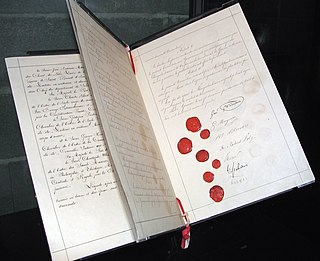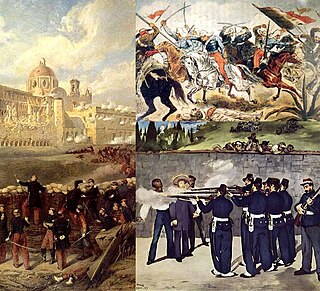 W
WThe Treaty of Amity and Commerce between France and Japan (Japanese:日仏修好通商条約) (1858) opened diplomatic relations and trade between the two counties.
 W
WThe Ansei Treaties (Japanese:安政条約) or the Ansei Five-Power Treaties (Japanese:安政五カ国条約) are a series of treaties signed in 1858, during the Japanese Ansei era, between Japan on the one side, and the United States, Great Britain, Russia, Netherlands and France on the other. The first treaty, also called the Harris Treaty, was signed by the United States in July 1858, with France, Russia, Britain and the Netherlands quickly followed within the year: Japan was forced to apply to other nations the conditions granted to the United States under the "most favoured nation" provision.
 W
WThe Cobden–Chevalier Treaty was an Anglo-French free trade agreement signed between Great Britain and France on 23 January 1860. After Britain began free trade policies in 1846, there remained tariffs with France. The 1860 treaty ended tariffs on the main items of trade – wine, brandy and silk goods from France, and coal, iron and industrial goods from Britain. The economic effects were small, but the new policy was widely copied across Europe. According to Stephen Krasner, the treaty set off a "golden age of free trade" in Europe, which was lasted until the late 1870s. It was the first of eight "most favored nation" treaties the British negotiated in the 1860s. By the 1880s, however, the rise of protectionism in Germany, the United States and elsewhere made the treaty less relevant. It was the first modern trade agreement.
 W
WThe First Geneva Convention for the Amelioration of the Condition of the Wounded in Armies in the Field, held on 22 August 1864, is the first of four treaties of the Geneva Conventions. It defines "the basis on which rest the rules of international law for the protection of the victims of armed conflicts." After the first treaty was adopted in 1864, it was significantly revised and replaced in 1906, 1929, and finally 1949. It is inextricably linked to the International Committee of the Red Cross, which is both the instigator for the inception and enforcer of the articles in these conventions.
 W
WThe Treaty of London, often called the Second Treaty of London after the 1839 Treaty, granted Luxembourg full independence and neutrality. It was signed on 11 May 1867 in the aftermath of the Austro-Prussian War and the Luxembourg Crisis. It had wide-reaching consequences for Luxembourg and for relations among Europe's Great Powers.
 W
WThe Second French Intervention in Mexico, also known as the Second Franco-Mexican War and the Mexican Adventure, was an invasion of Mexico, launched in late 1861, by the Second French Empire (1852–1870). Initially supported by the United Kingdom and Spain, the French intervention in Mexico was a consequence of Mexican President Benito Juárez's imposition of a two-year moratorium of loan-interest payments from July 1861 to French, British, and Spanish creditors. To extend the influence of Imperial France, Napoleon III instigated the intervention in Mexico by claiming that the military adventure was a foreign policy commitment to free trade. The establishment of a European-derived monarchy in Mexico would ensure European access to Mexican resources, particularly French access to Mexican silver. To realize his ambitions without interference from other European nations, Napoleon III of France entered into a coalition with the United Kingdom and Spain.
 W
WThe Convention or First Convention of Peking is an agreement comprising three distinct treaties concluded between the Qing dynasty of China and Great Britain, France, and Russian Empire in 1860. In China, they are regarded as among the unequal treaties. The Ministry of Foreign Affairs of the Republic of China keeps the original copy of the convention in the National Palace Museum in Taiwan.
 W
WThe Treaty of Tientsin, now also known as the Treaty of Tianjin, is a collective name for several documents signed at Tianjin in June 1858. They ended the first phase of the Second Opium War, which had begun in 1856. The Qing, Russian, and Second French Empires, the Great Britain, and the United States were the parties involved. These treaties, counted by the Chinese among the so-called unequal treaties, opened more Chinese ports to foreign trade, permitted foreign legations in the Chinese capital Beijing, allowed Christian missionary activity, and effectively legalized the import of opium.
 W
WThe Treaty of Dappes was concluded on 8 December 1862 between France and the Swiss Confederation. Resolving a long-standing border dispute between the two countries, the accord awarded the Vallee des Dappes to France, in exchange for a comparable piece of territory just to the north. The treaty is noteworthy for dividing the tiny village of La Cure between the two countries, with the new border bisecting not just the town itself, but several structures within it.
 W
WThe Treaty of Paris of 1856 brought an end to the Crimean War between the Russian Empire and an alliance of the Ottoman Empire, Great Britain, the Second French Empire and the Kingdom of Sardinia.